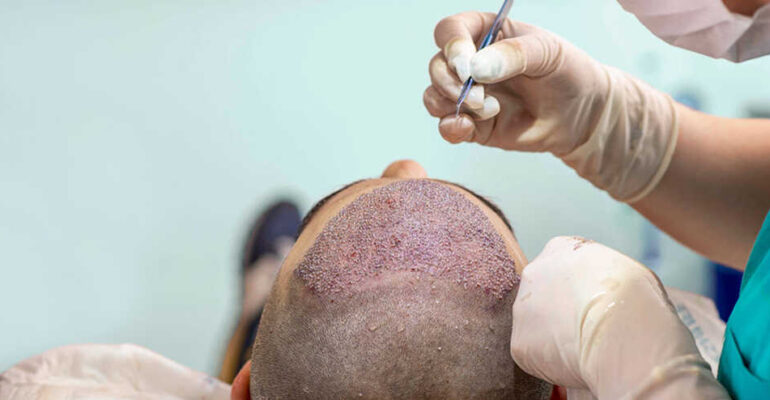Hair Transplant: A Comprehensive Dermatologist Guide
October 26, 2018 2025-04-24 11:48Hair Transplant: A Comprehensive Dermatologist Guide
As an Amazon associate, Dermatocare earns from valid purchase made by clicking on the affiliate links in this blog.

Hair Transplant: A Comprehensive Dermatologist Guide
Hair transplantation is a minimally invasive surgical procedure designed to restore hair in areas affected by baldness, especially androgenetic alopecia or male pattern baldness. Among the various methods available today, Follicular Unit Extraction (FUE) stands out as one of the most advanced and popular techniques due to its precision, minimal downtime, and natural-looking results.
Types of Hair Transplant Techniques
- Follicular Unit Extraction (FUE)
In FUE, follicular units are extracted individually from the donor area—typically the occipital scalp—using micro punches. These units are then transplanted into bald or thinning areas such as the scalp, eyebrows, or beard. FUE is favored for its minimal scarring and faster recovery. - Follicular Unit Transplantation (FUT)
Also known as the “strip” method, FUT involves removing a strip of skin from the donor area, dissecting it under a microscope into individual follicular units, and implanting them into the recipient site.
Preparation Before FUE Hair Transplant
- Clinical Examination
A thorough history is taken to assess the pattern, progression, and family history of hair loss. FUE is best suited for patients with stable hair loss and a good donor density. - Medical Evaluation
Despite being minimally invasive, a full medical work-up including blood tests is essential to rule out bleeding disorders or other contraindications. Anticoagulants should be stopped at least a week prior. - Pre-Procedure Counselling
Detailed discussions are held covering the number of grafts required, expected results, costs, and post-op precautions. Pre-operative photographs are taken to document baseline scalp status.
Procedure on the Day of FUE
- Hair Wash & Breakfast
A clean scalp is crucial, and since only local anaesthesia is used, a light breakfast is encouraged. - Donor Area Preparation
The donor area is trimmed and sterilized. - Local Anaesthesia
The procedure is performed under local anaesthesia, ensuring the patient remains conscious but pain-free. - Follicular Unit Extraction
Hairs are removed in their natural groupings (1–5 hairs per follicular unit) either manually or using a mechanical punch. - Implantation
The grafts are preserved in a biocompatible solution and strategically implanted into the bald region following the natural angle and density of hair growth. - Duration
The procedure typically takes 4–6 hours. In cases of larger transplants, it may extend up to a full day. - Bandaging
Once implantation is completed, both donor and recipient areas are cleaned and bandaged carefully.
Post-Operative Healing and Care
- Antibiotics and Painkillers
A short course is usually prescribed to prevent infection and alleviate discomfort. - Next-Day Review
Patients should revisit the clinic for cleaning and inspection of the grafted area. - Saline Spray
To keep grafts hydrated, saline spray should be applied every 2 hours for the first 5 days. - Hair Washing
A gentle shampoo can be used after 3 days without rubbing the scalp. - Scab Care
Scabs will naturally fall off in 7–10 days. Avoid forceful removal. - Swelling
Mild swelling around the forehead or eyes may occur but typically resolves within a week. Sunglasses or caps can be used to conceal this. - Return to Work and Activity
Most patients can return to work in 1–2 days. However, rigorous activities such as gym, swimming, or outdoor sports should be avoided for 3 weeks. - Sun Protection
Avoid direct sun exposure for at least 3 weeks. A cap can help protect the scalp from UV rays and pollution.
When to Expect Hair Regrowth?
New hair begins to grow at 3–4 months post-transplant. Full results, including density and texture, are generally visible at 9–12 months.
Conclusion
Hair transplantation, especially the FUE method, offers an effective and lasting solution for those with patterned hair loss. With meticulous planning, skilled execution, and diligent post-operative care, one can achieve a natural and confident appearance.
👉 Use the Dermatocare Regime Finder Tool to discover a personalized hair regrowth plan suitable for early stages of male pattern baldness.
ROUTINE FINDER
Get free dermatologist-recommended regime by choosing your skin or concerns.

FACE

HAIRS

CHILD

BODY




